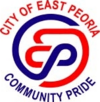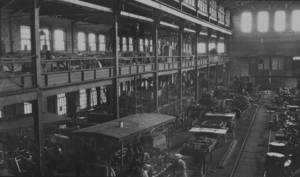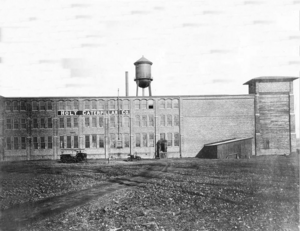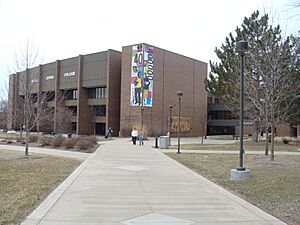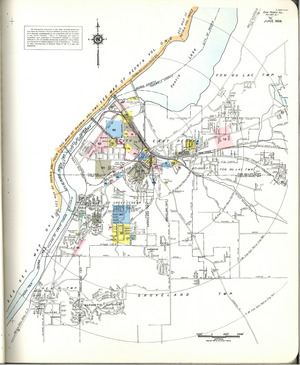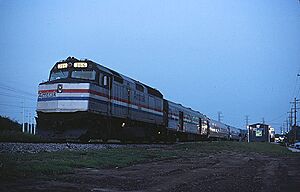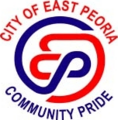East Peoria, Illinois facts for kids
Quick facts for kids
East Peoria
|
|||
|---|---|---|---|
|
|||

Location of East Peoria in Tazewell County, Illinois.
|
|||
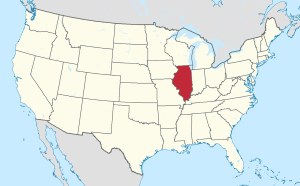
Location of Illinois in the United States
|
|||
| Country | United States | ||
| State | Illinois | ||
| County | Tazewell | ||
| Founded | July 1884 | ||
| Area | |||
| • Total | 22.71 sq mi (58.81 km2) | ||
| • Land | 20.41 sq mi (53.57 km2) | ||
| • Water | 1.73 sq mi (5.24 km2) | ||
| Elevation | 499 ft (152 m) | ||
| Population
(2020)
|
|||
| • Total | 22,484 | ||
| • Density | 1,087.02/sq mi (419.70/km2) | ||
| Time zone | UTC−6 (CST) | ||
| • Summer (DST) | UTC−5 (CDT) | ||
| ZIP Code(s) |
61611, 61630
|
||
| Area code(s) | 309 | ||
| FIPS code | 17-22164 | ||
| GNIS ID | 2394604 | ||
| Wikimedia Commons | East Peoria, Illinois | ||
East Peoria is a city in Tazewell County, Illinois, United States. In 2020, about 22,484 people lived there. East Peoria is part of the larger Peoria, Illinois area, located right across the Illinois River from downtown Peoria.
The city is well-known for being home to many Caterpillar Inc. factories. You can also find the Par-A-Dice Hotel and Casino and a big shopping and business area called the Levee District here. East Peoria is also famous for its Festival of Lights, a huge Christmas light display that brings in thousands of visitors every year.
Contents
History of East Peoria
Early Settlements and Names
After Illinois became a state in 1818, four men named William Blanchard, Charles Sargeant, Theodore Sargeant, and David Barnes crossed the Illinois River from Peoria. They found a swampy area but decided to settle there, building huts and growing crops. They called their new home "Fondulac Township," which means "bottom of the lake" in French.
More settlers arrived over time, including Jacob L. Wilson and Thomas Camelin. Wilson even became the local Justice of the Peace, helping to keep order in the growing community.
In 1855, the town of Fondulac was officially mapped out. It had three main streets and important businesses like a saw mill. A railroad was also built, which helped the town send and receive farm products. Later, in 1864, another area nearby was mapped out and called "Bluetown." Some say it got its name because a settler named Joseph Schertz always wore blue clothes.
Becoming East Peoria
On July 1, 1884, the people of Fondulac and Bluetown voted to join together. They decided to become one village called "Hilton." The name might have come from a local coal mining company. Nicholas Slagle was chosen as the first president of the new village.
Five years later, in October 1889, the village changed its name again to "East Peoria." This new name made sense because the village was located just east of the city of Peoria. Finally, in April 1919, East Peoria officially became a city.
Geography and Climate
East Peoria covers about 22 square miles. Most of this area is land, but about 1.73 square miles is water, including parts of the Illinois River.
Weather in East Peoria
East Peoria has a climate with warm summers and cold winters.
| Climate data for East Peoria, Illinois, 1991–2020 normals | |||||||||||||
|---|---|---|---|---|---|---|---|---|---|---|---|---|---|
| Month | Jan | Feb | Mar | Apr | May | Jun | Jul | Aug | Sep | Oct | Nov | Dec | Year |
| Mean daily maximum °F (°C) | 30 (−1) |
33 (1) |
49 (9) |
59 (15) |
71 (22) |
79 (26) |
81 (27) |
81 (27) |
77 (25) |
63 (17) |
48 (9) |
37 (3) |
59 (15) |
| Mean daily minimum °F (°C) | 20 (−7) |
21 (−6) |
34 (1) |
43 (6) |
55 (13) |
63 (17) |
65 (18) |
64 (18) |
57 (14) |
47 (8) |
35 (2) |
27 (−3) |
44 (7) |
| Average precipitation inches (mm) | 2.1 (53) |
2.2 (56) |
3.4 (86) |
4.8 (120) |
5.8 (150) |
5.4 (140) |
4.6 (120) |
3.8 (97) |
3 (76) |
3.3 (84) |
2.2 (56) |
2 (51) |
42.6 (1,089) |
| Average precipitation days (≥ 0.01 in) | 4 | 3 | 6 | 7 | 9 | 8 | 7 | 6 | 4 | 5 | 5 | 4 | 68 |
| Average snowy days (≥ 0.1 in) | 13 | 10 | 5 | 2 | 0 | 0.0 | 0.0 | 0.0 | 0.0 | 0 | 3 | 8 | 41 |
| Average relative humidity (%) | 81 | 81 | 74 | 74 | 77 | 67.3 | 84 | 81 | 74 | 69 | 72 | 78.0 | 76.0 |
| Mean monthly sunshine hours | 121 | 126 | 162 | 157 | 190 | 236 | 248 | 259 | 253 | 209 | 192 | 150 | 2,303 |
| Source: Weather WX Monthly Averages | |||||||||||||
People of East Peoria
| Historical population | |||
|---|---|---|---|
| Census | Pop. | %± | |
| 1890 | 392 | — | |
| 1900 | 899 | 129.3% | |
| 1910 | 1,493 | 66.1% | |
| 1920 | 2,214 | 48.3% | |
| 1930 | 5,027 | 127.1% | |
| 1940 | 6,806 | 35.4% | |
| 1950 | 8,698 | 27.8% | |
| 1960 | 12,310 | 41.5% | |
| 1970 | 18,671 | 51.7% | |
| 1980 | 22,385 | 19.9% | |
| 1990 | 21,378 | −4.5% | |
| 2000 | 22,638 | 5.9% | |
| 2010 | 23,402 | 3.4% | |
| 2020 | 22,484 | −3.9% | |
| U.S. Decennial Census | |||
In 2020, East Peoria had 22,484 residents living in 9,658 households. About 25.7% of these households had children under 18. The average household size was 2.31 people.
The population is made up of different age groups. About 20.1% are under 18, and 19.6% are 65 or older. The average age in East Peoria is 41.9 years.
Most people in East Peoria identify as White (90%). Other groups include African American (1.6%), Asian (0.97%), and people from two or more races (6%). About 2.2% of the population is Hispanic or Latino.
The median income for a household in East Peoria is about $68,246 per year. For families, it's higher, around $88,008.
Economy and Businesses
East Peoria has a strong economy, especially in manufacturing and entertainment.
Manufacturing in East Peoria
Peoria Brick Company
East Peoria had a lot of clay and shale, which are great for making bricks. The Peoria Brick Company started in 1899, making bricks for buildings and roads. At first, they made 40,000 bricks a day with 60 employees.
Over the years, the company grew and changed. They started using gas and electricity instead of coal and wood. While they stopped making bricks in 1982, the company now sells many different building and landscaping materials. It's still run by the same family that started it!
Caterpillar Inc.
The Holt Manufacturing Company from California, which made tractors, decided to open a factory in East Peoria in 1909. They bought an old factory that was perfect for making farm equipment. This new factory, called "Holt Caterpillar Company," started with 12 employees in 1910.
The East Peoria factory was very successful. Just two years later, it had 625 employees and was sending tractors to other countries. Holt was famous for creating the first practical continuous tracks for tractors, which he called "Caterpillar."
In 1925, Holt Caterpillar merged with another company to form the Caterpillar Tractor Co.. The new company moved its main office to Peoria in 1930. During World War I, Caterpillar tractors were used by armies to pull heavy equipment, showing how important their crawling tracks were. These tractors even helped inspire the design of the first tanks!
Fun and Entertainment
Par-A-Dice Hotel and Casino
The Par-A-Dice Hotel and Casino is a large riverboat casino located on the Illinois River in East Peoria. It first opened in 1991 in Peoria and then moved to East Peoria in 1993. It's a popular spot for entertainment.
For many years, the riverboat would cruise daily. However, in 1999, Illinois changed the rules so casinos didn't have to leave their docks. In 2010, the rules changed back, and the Par-A-Dice started cruising the river again.
The Levee District
The Levee District is East Peoria's main shopping and business area. It's a modern area with many restaurants, stores, and places to stay. Before, this area was a large Caterpillar factory.
In 1998, the factory was taken down, leaving an empty space. The city bought the land in 2000 and decided to turn it into a lively commercial center. Now, people in East Peoria don't have to travel to Peoria for shopping and dining; they can find everything they need right at home.
Arts and Culture
Fondulac District Library
The Fondulac District Library started in 1935. It has moved several times to bigger locations as its collection grew. Today, the library offers many things, including books, magazines, board games, and even Wi-Fi hotspots.
A New Home for the Library
In 2009, people in East Peoria voted to build a brand new library. Construction began in 2012, and the new library opened its doors on November 1, 2013. This modern library is much larger and has more media for everyone to enjoy.
The library shares a common area, called the Civic Complex, with the East Peoria City Hall. The library has different sections on its two floors, including a children's department and areas for adults and local history. There are also public computers and study rooms.
Outside the library, you can find Levee Park, which has a special reading garden. This garden has seating, shade, a water fountain, and a "Free Little Library" where people can share books. It was built with donations from the community.
Festival of Lights
Every year, from Thanksgiving until early January, East Peoria hosts the amazing Festival of Lights. It started in 1984 as a parade where floats covered in Christmas lights drove through town.
In 1986, a special float shaped like a riverboat, called the E.P. Noel Riverboat, became very popular. Since then, many floats have been made with special steel and animated features.
In 1993, the Winter Wonderland drive-through was built. All the festive floats and displays stay here for the whole festival. About 25,000 visitors come to see them each year.
The symbol of the Festival of Lights is a cute wooden toy soldier named FOLEPI. This name stands for Festival of Lights, East Peoria, Illinois. In 2020, the Festival of Lights even won the "Heavyweights Champion" title on a TV show called The Great Christmas Light Fight!
Parks and Recreation
The East Peoria Park District manages over 1,600 acres of land for fun activities. You can visit places like Carl Spindler Marina Campground, which overlooks the Illinois River. Other spots include Fon du Lac Farm Park and Recreational Courts and Skate Park.
East Peoria also has two golf courses: Fon du Lac Golf Course and Quail Meadows.
Levee Park Development
Levee Park, located behind the Fondulac District Library, is being improved to offer more to visitors. The first part of the plan was the reading garden for the library. Future plans include outdoor restrooms, a splashpad, and a covered outdoor stage for events. These improvements are being paid for by grants and donations.
Sports in East Peoria
The EastSide Centre is a big sports complex on the east side of town. It has facilities for many sports, like basketball, baseball, softball, soccer, and lacrosse. There's also a walking track and a gym.
This center is used for sports events for schools and colleges. It often hosts state championships for high school softball and junior high track and baseball.
Education in East Peoria
East Peoria has several schools and a community college.
Schools for Kids and Teens
The city is served by different elementary school districts, including East Peoria School District 86, Creve Coeur School District 76, and Robein School District 85. These elementary schools feed into East Peoria Community High School District 309, which has one high school.
- East Peoria Elementary School District 86: This district has schools for students from kindergarten to 8th grade.
- Robein School District 85: This district has one school for K-8th grade in the Robein area.
- East Peoria Community High School District 309: This district has one high school, East Peoria High School, for grades 8-12.
College Education
Illinois Central College (ICC) is a community college located at the edge of East Peoria. It also has campuses in Peoria and Pekin. ICC serves students from ten different counties in central Illinois.
The idea for the college was approved by voters in 1966. The first semester started in 1967 with about 2,486 students. Over the years, the college grew, adding more programs and campuses. It even built a special training building with Caterpillar, showing how the college works with local businesses.
ICC offers many types of programs, including those that help students transfer to a four-year university, get job-ready certificates, or earn degrees.
Media and News
East Peoria has a history of local newspapers. The first one, The Pilot, started in 1901. Later, the East Peoria Post was published weekly. In 1927, the East Peoria Courier began, founded by Aaron K. Brill.
Over the years, the newspaper changed names a few times, becoming the Tazewell Courier and then going back to East Peoria Courier. In 1997, it was renamed the East Peoria Times-Courier, which is its current name.
East Peoria is also home to many TV stations that serve the Peoria area. For example, WEEK-TV (channel 25), the local NBC station, has its studios and broadcast towers here. Other stations, like MyNetworkTV affiliate WTVK (channel 59) and ABC affiliate WHOI (channel 19), have also moved their operations to East Peoria.
Getting Around East Peoria
Roads and Highways
East Peoria is connected by major roads. Interstate 74 runs through the northern part of the city, linking it to Peoria via the Murray Baker Bridge. U.S. Route 150 is another important road that goes through East Peoria.
Several state routes also pass through the city:
- Illinois Route 8 runs parallel to I-74.
- Illinois Route 29 splits from I-74 and goes southwest.
- Illinois Route 40 enters from the Bob Michel Bridge and runs south.
- Illinois Route 116 enters East Peoria from the west.
Trains and Buses
East Peoria has two local railroads: the Tazewell and Peoria Railroad and the Toledo, Peoria and Western Railway. These railroads are important for transporting goods for businesses like Caterpillar.
For public transportation, the Greater Peoria Mass Transit District offers bus service called CityLink. These buses serve East Peoria, Illinois Central College, and other nearby towns.
Flying In and Out
The General Wayne Downing Peoria International Airport is located just west of Peoria and serves the entire area. It has three passenger airlines and many cargo carriers, making it easy to travel by air.
Notable People from East Peoria
- Joe Girardi: A famous baseball catcher and former manager for the New York Yankees. He grew up in East Peoria.
- Sam Kinison: A well-known comedian and actor who attended East Peoria Community High School.
- Roger Phegley: A basketball player who played for several National Basketball Association teams. He played both baseball and basketball at East Peoria Community High School.
- Gary Richrath: A talented guitarist and songwriter for the band REO Speedwagon.
Images for kids
See also
 In Spanish: East Peoria para niños
In Spanish: East Peoria para niños



